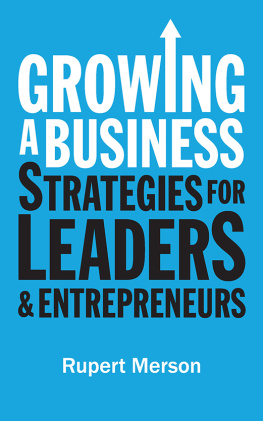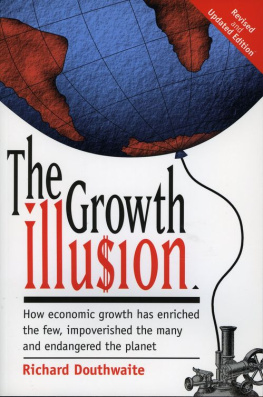GUIDE TO MANAGING GROWTH
OTHER ECONOMIST BOOKS
Guide to Analysing Companies
Guide to Business Modelling
Guide to Business Planning
Guide to Economic Indicators
Guide to the European Union
Guide to Financial Management
Guide to Financial Markets
Guide to Hedge Funds
Guide to Investment Strategy
Guide to Management Ideas and Gurus
Guide to Organisation Design
Guide to Project Management
Guide to Supply Chain Management
Numbers Guide
Style Guide
Book of Obituaries
Brands and Branding
Business Consulting
Business Strategy
Buying Professional Services
The City
Coaching and Mentoring
Doing Business in China
Economics
Emerging Markets
Headhunters and How to Use Them
Mapping the Markets
Marketing
Organisation Culture
Successful Strategy Execution
The World of Business
Directors: an AZ Guide
Economics: an AZ Guide
Investment: an AZ Guide
Negotiation: an AZ Guide
Pocket World in Figures

GUIDE TO MANAGING GROWTH
Turning success into even bigger success
Rupert Merson

THE ECONOMIST IN ASSOCIATION WITH PROFILE BOOKS LTD. AND PUBLICAFFAIRS
Copyright The Economist Newspaper Ltd, 2011
Text copyright Rupert Merson, 2011
First published in 2011 by Profile Books Ltd. in Great Britain.
Published in 2014 in the United States by PublicAffairs,
a Member of the Perseus Books Group
All rights reserved.
Printed in the United States of America.
No part of this book may be reproduced, stored in or introduced into a retrieval system, or transmitted, in any form or by any means (electronic, mechanical, photocopying, recording or otherwise), without the prior written permission of both the copyright owner and the publisher of this book, except in the case of brief quotations embodied in critical articles and reviews. For information, address PublicAffairs, 250 West 57th Street, 15th Floor, New York, NY 10107.
The greatest care has been taken in compiling this book. However, no responsibility can be accepted by the publishers or compilers for the accuracy of the information presented.
Where opinion is expressed it is that of the author and does not necessarily coincide with the editorial views of The Economist Newspaper.
While every effort has been made to contact copyright-holders of material produced or cited in this book, in the case of those it has not been possible to contact successfully, the author and publishers will be glad to make amendments in further editions.
PublicAffairs books are available at special discounts for bulk purchases in the U.S. by corporations, institutions, and other organizations. For more information, please contact the Special Markets Department at the Perseus Books Group, 2300 Chestnut Street, Suite 200, Philadelphia, PA 19103, call (800) 810-4145, ext. 5000, or e-mail special.markets@perseusbooks.com.
Typeset in EcoType by MacGuru Ltd
info@macguru.org.uk
Library of Congress Control Number: 2014932175
ISBN 978-1-61039-517-5 (EB)
First Edition
10 9 8 7 6 5 4 3 2 1
Contents
Acknowledgements
AS IS EVIDENT on every page of this book, a huge debt is owed to a wide range of previous thinkers and writers. Where possible acknowledgements have been made directly in the text or in the endnotes. If any have been missed I apologise.
Particular thanks are owed to my fellow faculty members at London Business School from whom Ive learned an enormous amount particularly Keith Willey, with whom I have taught a course called Managing the Growing Business for over ten years, and John Bates, without whom I would not have been at LBS at all.
I would also like to acknowledge the contributions of former colleagues at BDO, particularly Iain Henderson and Don Williams in London, and Maria Karalis in New York.
Lastly, I would like to thank my wife, with whom I have shared this book on too many family holidays.
Introduction
MANY NEW OR successful businesses seek to grow, but the achievement of growth can be problematic and requires thoughtful and skilful management, not least because of the many questions it raises. What do we mean by growth? What kind of growth is desirable? How does a business change as it grows? How should owners and managers deal with this change? Is there an optimum rate of growth? Can a business grow too quickly? To what extent can and should managers control the rate of growth in a business? What are the real costs of growth: not just the financial costs, but the personal costs, particularly to those on the inside of the organisation? What are the enablers of growth, and are there levers that managers can pull that will help the business grow further and faster? Is growth itself an inevitable concomitant of success or can you have success without it? Is growth even desirable? What are the barriers to growth? Do the answers to these questions change from industry to industry, from country to country and culture to culture?
Part of the problem when thinking about growth is that those involved have to get used to thinking about organisations as transient things in a permanent state of flux. Many ambitious, younger managers will have experienced walking into a new organisation and quickly forming a view of what is wrong with the place. When Im in charge Ill sort out this and correct that and fire him and promote her and everything will then be fine. But once they are in charge many of these individuals realise that management is not that simple; that problems change even as you attempt to solve them; and that next years problem is complicated by rather than resolved by last years solution.
The management of change is never easy, and in a growing business change can be both fast and complex. Even if growth is a consequence of success, it brings organisational challenges that threaten the success that caused it. In order to sustain growth it is important to realise that what worked last year will not necessarily work next year; an organisation that wants to manage growth successfully needs to change things that are not yet broken.
Change inside an organisation is compounded by changes outside it. Indeed, growth in a business itself often triggers change in a market and industry, which in turn demands further change in the business. Growth may attract competitors, competing technologies and regulators, as well as customers from different markets with different expectations.
Growth gives rise to problems for businesses of all sizes. Different divisions in a big business evolve at different speeds and may be at different stages of their evolution, each with its own problems with the additional problem for the organisation as a whole that the plans of the divisions be satisfactorily reconciled with each other. Mergers, joint ventures and acquisitions different routes for getting big bring other challenges, not least with integration. Small businesses have different sorts of growth challenges as they seek to establish credibility as well as culture, brand and identity, develop secure lines of supply and sustainable relationships with customers and financiers, and manage the changing relationship between owners and managers. An established business in one country investing in a small venture in another needs to acknowledge not just the legal and cultural differences between the two countries, but also the differences between managing a large, corporate business and a small entrepreneurial firm.
Next page







